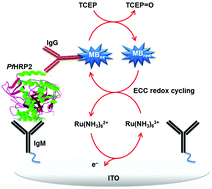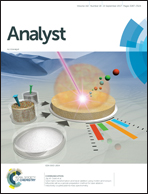An ultrasensitive enzyme-free electrochemical immunosensor based on redox cycling amplification using methylene blue†
Abstract
We report a new enzyme-free electrochemical sensor for ultrasensitive measurements of protein biomarkers in plasma and whole blood samples based on a unique electrochemical–chemical–chemical (ECC) redox cycling signal amplification scheme. This scheme uses methylene blue (MB) as a redox indicator which undergoes an endergonic reaction with Ru(NH3)63+ and a highly exergonic reaction with tris(2-carboxyethyl)phosphine (TCEP). This approach offers improved detection sensitivity and sensor stability compared with enzyme-based ECC redox cycling techniques, while involving a simpler sensor modification process and detection protocol. This redox cycling scheme was combined with a robust immunosandwich assay for quantitative measurements of protein biomarkers. For proof of principle, Plasmodium falciparum histidine-rich protein 2 (PfHRP2) was measured in human plasma and whole blood samples, which could be detected down to 10 fg mL−1 and 18 fg mL−1, respectively. Furthermore, this immunosensor exhibits high selectivity, excellent reproducibility and good stability for up to 2 weeks, making it a promising platform for point-of-care testing, especially for detecting extremely low biomarker concentrations in raw biofluids.



 Please wait while we load your content...
Please wait while we load your content...